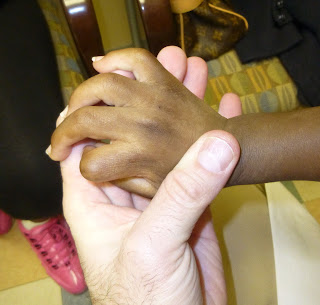There are number of different varieties of chromosomal disorders in which there is an extra chromosome, leading to a total of 47 chromosomes instead of the typical 46 (23 pairs). The most notable trisomy is Downs Syndrome, Trisomy 21. The more common other trisomies include Trisomy 18 (Edwards syndrome) and Trisomy 13 (Patau syndrome). Finally, the sex chromosomes can be affected as well- XXX and XXY (Klinefelter syndrome).
Trisomy 8 can be complete (which is usually fatal causing a miscarriage) or can be mosaicism which is less severe and may cause some development delay, decreased IQ, and other physical abnormalities. This can include short or tall stature, limited facial expressions with wide spaced eyes, a large forehead, and a broad upturned nose. Another name for Trisomy 8 is Warkany syndrome 2. It is caused by a random error in the egg or sperm is without a family history.
For the hand surgeon, the most notable musculoskeletal difference is camptodactyly. This syndromic associated camptodactyly is different than others we have discussed in that it can be more severe and less responsive to stretching. See previous post: http://congenitalhand.wustl.edu/2012/03/camptodactyly.html
Nonetheless, the first step in treatment remains stretching and splinting as possible. If the bent position of the fingers is limiting function and nonoperative intervention is not helping, surgery can be considered. This child is being treated with therapy alone. Mom (who was kind enough to allow us to post this picture) is stretching the camptodactyly and there is a forearm based hand splint to extend the fingers at the PIP joints.
 |
| Appearance of Trisomy 8, mosaicism. Note his facial characteristics and also the cast on his right foot after clubfoot treatment. |
 |
| Resting appearance of right hand. Not index finger camptodactyly especially. |
 |
| Isolated camptodactyly of index finger. The finger is in approximately 90 of flexion. |
 |
| X- ray appearance . See especially the index and small fingers with camptodactyly. |